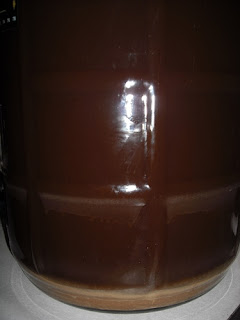First we need to understand what yeast is and in particular, the absolute awesomeness of Saccharomyces cerevisiae or Bread and Brewers yeast. Shocking I know, but it is true. Both Bread Yeast and Brewers Yeast (at least the Ale yeast, Lager yeast is different) are the same species. Granted, they are different strains within the species, but the function they perform and the temperature they perform it at, is the same. This particular species of yeast breaks down sugars and converts them to CO2 and Ethanol. In fact, the name for the species, loosely translated, means "Sugar eating, alcohol maker". LOL
Now this is where the strain becomes important... With bread yeast there is more CO2 and less alcohol... and the alcohol that is produced evaporates off almost immediately upon baking. Where as the Brewer strains produce CO2 and alcohol, but also more esters and various other beer flavored compounds.
So what exactly is the yeast doing in that fermentor....? Technically, it's this....
C6H12O6 + H2O ------} CO2 + CH3CH2OH (or C2H5OH)
Translated as:
Sugar (glucose) plus Water = Carbon Dioxide plus Ethanol (alcohol)
Though to be honest, after you first pitch the yeast, it's not really doing a whole lot of this. The yeast has 3 stages in it's life cycle... They are commonly referred to as Respiration, Fermentation and Flocculation/Sedimentation. Those can actually be broken down a little further...
Respiration - When the yeast have decided they have reached their maximum population. They begin to grow, consuming Oxygen, Phosphorus and Nitrogen compounds (Amino Proteins from the Protein rest). There is very little CO2 being produced at this time, and no ethanol. Just hang tight, they will get there. They need to be all strong and healthy before they can do their fermentation thing....
Fermentation - Once most of the Oxygen has been consumed during respiration and the baby yeasts are all grown up and stuff, they begin to consume the sugars. This is when they begin releasing CO2 and Ethanol along with other esters and other compounds that, in the case of German Weizen yeast, will lend to the fruity-spice aroma that most describe as Banana-Clove. Other chemicals produced during this phase will lead to other aromas and flavors. This is determined by the strain of yeast used. Any remaining oxygen will be pushed out of the carboy by the CO2 production. The initial phase of fermentation is where the kraeusen (Kroy-zen) is produced which will consist of unused proteins, dead yeast and tannins from the grain hulls which have trapped the CO2, forming the craggy foam (blow-off).
Attenuation, Flocculation & Sedimentation - Attenuation is the measure of how much of the fermentable sugars will be consumed by the yeast. All yeast strains have different attenuation percentages. Meaning how much of the sugar they will be able to ferment. Lager type yeasts (bottom-fermenting) usually have a higher attenuation rating leading to dryer more crisp beers while Ale type yeasts (Top-Fermenting) leave a little more sugar behind resulting in malty overtones. Once the yeast reach their attenuation point, the majority will stop producing alcohol & CO2 and begin using the last of the sugars to rebuild their glycogen stores, clump together and go into a dormant state (Flocculation). When this dormancy happens, they fall out of suspension in the wort and settle to the bottom of the carboy. This sediment which includes yeast and various other compounds from the wort is called trub (troob).
There will still be yeast suspended in the beer and some of it will still be fermenting.... So it's not over yet.... This is more of a population vs available food issue...
Once there is significant accumulation of trub in the bottom of your carboy, it is a good practice to perform what is called "racking". This process is simply the moving of the beer from one carboy to another sanitized carboy by siphoning it out, leaving the trub behind. Some will argue that with small 5 gallon batches this really isn't necessary, but I think it depends on the strain of yeast you are using. This trub can cause some nasty solvent type flavors in your finished beer... better safe than sorry.
Secondary Fermentation - Once this initial explosion of activity is over, their is a second fermentation phase that occurs though it is much slower than the first which produced all the kraeusen and eventually all the trub. Even though a lot of the yeast have flocculated and settled out of the wort, there is still active yeast in suspension... So once the beer is racked allow it to ferment a little longer.
Back to the Dunkelwiezen.........
For my Dunkleweizen, I was being a little paranoid, so the trub had to go. I was not about to risk having any off flavors in my finished beer.
So after 1 week of fermentation, I racked the Dunkel into a second clean and sanitized carboy... Be sure when you do this to incorporate as LITTLE oxygen as possible or it will throw off your yeast fermentation and cause oxidation to the beer.
(so shove that siphon tube ALL the way down into the bottom of the second carboy so you don't have any splashing)
I did take another gravity reading and it had dropped to 1.016... A significant drop from 1.058.... This meant that my beer would be ready to bottle in about 5 -7 more days.
Then simply replace the fermentation lock on it.
In the next post..... Primed and Ready..... To Bottle That Is
Cin Cin!!
~~









No comments:
Post a Comment